|
|
Albert Einstein, German-born theoretical physicist and Nobel laureate (theory of relativity), born in Ulm, German Empire (d. 1955)
1879 Highlights
Day of the Week: Friday
How Long Ago? 142 years, 2 months and 10 days
Leap Year: No
https://www.onthisday.com/date/1879/march/14
FRIDAY=VENICE=VENUS=VIERNES
|
|
|
|
|
Does space "flow" like a river? There's an analogy in General Relativity ... Why The Theory of Relativity Doesn't Add Up (In Einstein's Own Words).
|
|
|
|
|
Does space "flow" like a river? There's an analogy in General Relativity ... Why The Theory of Relativity Doesn't Add Up (In Einstein's Own Words).
|
|
|
|
|
The string theory time travel paradox^2
Tanuj Handa
Tanuj Handa
IITR | IIT-BHU | USCT | Developing research and creativity quotient | Curious about life |
Fecha de publicación: 28 oct 2019
Time is like a river, it swifts and shores in one direction
This is a notion with which everyone must be familiar with, the obsession to know more about the universe and how things are happening the way they happen goes way back in 20,000 BC when cosmologist made attempts to describe the force which makes it all stable. Time is one leg of the chair of the universe in which we all stand, thus it is quite dangerous to tamper the force and experiment with it.
Consider this analogy of time and river, both have a unidirectional flow and we are just the boat sailing along whether be time or the river. Travelling backwards against the flow requires a lot of energy like what quoted by the theory of relativity E=mc^2 is the amount of energy we have to achieve, to begin with, time travel.
Now, as you might have a little idea about string theory, which discusses the how the river of time is divided into different streams and the stream which we get depends upon the actions we take in present.
From the concept of time travel, we can conclude that if we get enough energy we can flow back in time, but if we don't give it in the right direction, we might face consequences. Some of the hypothesis of the event that may follow are :
1. We can end up being an alternate form of reality ( the one we can't relate to from our past)
2. We might alter the space-time and end up having both the different reality come together
3. The concept to enter in an alternate reality may require more energy than to go in our reality of past, hence it might not be achieved
Following it all, it might be difficult to relate but consider like this, you have just started to move the boat against the stream but instead of going to the diversion from where you came in, you chose the alternate stream and thus you are in an alternate past. OR you try to go back to your path from where you came and suddenly the stream takes you to different diversion and you end up in an alternate reality of your time, both of which are equally exciting and terrifying.
My notion to say it as paradox square is because as both time travel and string theory are a big paradox in itself, it's quite difficult to imagine such an event to happen. The only way we can know it all when we get to know how to flow against the flow of time and look it all by ourselves.
https://www.linkedin.com/pulse/string-theory-time-travel-paradox2-tanuj-handa |
|
|
|
|
|
|
-
-
Illustration on the base of the obelisk, showing how it was raised into place in 1836
-
Hieroglyphs on the obelisk.
-
Hieroglyphs on the upper obelisk. The Pharaoh on his throne is portrayed at the top
The centrepiece of the Place de la Concorde is an ancient Egyptian obelisk decorated with hieroglyphics exalting the reign of the pharaoh Ramesses II. It is one of two which the Egyptian government gave to the French in the 19th century. The other one stayed in Egypt, too difficult and heavy to move to France with the technology at that time. On 26 September 1981 President François Mitterrand formally returned the title of the second obelisk to Egypt.[16]
The obelisk once marked the entrance to the Luxor Temple. The wali of Egypt, or hereditary governor, Muhammad Ali Pasha, offered the 3,300-year-old Luxor Obelisk as a diplomatic gift to France in 1829. It arrived in Paris on 21 December 1833. Three years later, it was hoisted into place, on top of the pedestal which originally supported the statue of Louis XV, destroyed during the Revolution. The raising of the column was a major feat of engineering, depicted by illustrations on the base of the monument. King Louis Philippe dedicated the obelisk on 25 October 1836.[17]
The obelisk, a yellow granite column, rises 23 metres (75 ft) high, including the base, and weighs over 250 tonnes (280 short tons). Given the technical limitations of the day, transporting it was no easy feat – on the pedestal are drawn diagrams explaining the machinery that was used for the transportation. The government of France added a gold-leafed pyramidal cap to the top of the obelisk in 1998, replacing the missing original, believed stolen in the 6th century BC.[18]
|
|
|
|
|
|
|
|
LAST UPDATED: 27 NOVEMBER 2024
You may know Paris for its cathedral Notre-Dame, the Eiffel Tower, its café culture and its amazing museums and art galleries. The French capital is also famous for its fantastic perspective that runs from the Louvre to La Défense. This is the ‘Voie Triomphale’, aka the Historical Axis of Paris.
This line is one of the most prestigious perspectives in the world. In fact, its design has inspired cities such as Buenos Aires, Washington DC, New Delhi and Canberra. In this article, we’ll learn more about the Historical Axis of Paris. We’ll discover the stunning monuments and I reveal to you some stunning facts.
What is the Historical Axis of Paris?
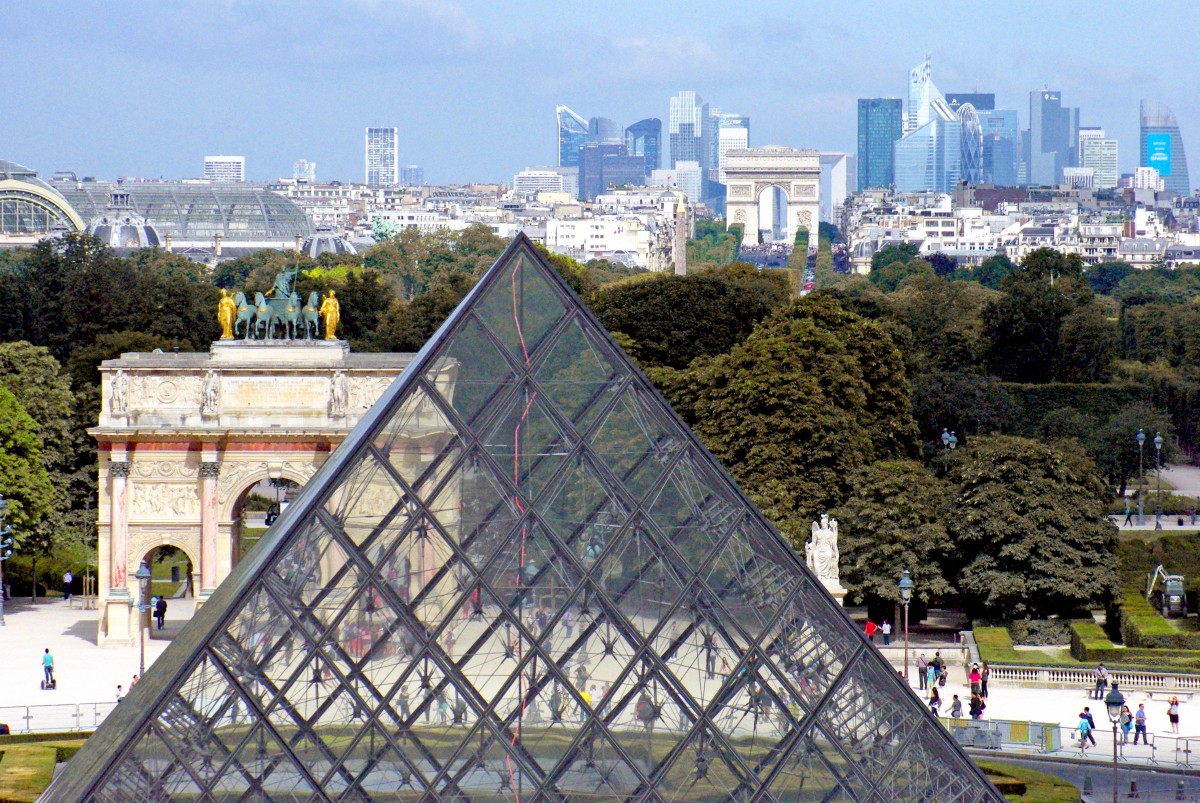 The glass pyramid and the historical axis of Paris © French Moments The glass pyramid and the historical axis of Paris © French Moments
The Historical Axis, also known in French as “Axe Historique”, “Voie Triomphale” or “Voie Royale” is orientated on a 26° angle.
It follows the course of the Sun from its rising in the East to its setting in the West.
Oddly, this angle of orientation is the same as that of Paris’ Notre-Dame Cathedral, some 1,000 metres away from the Louvre Palace.
More than just a series of monuments placed along the axis, it seems that a complex symbolism was at work in the mind of the successive urban planners.
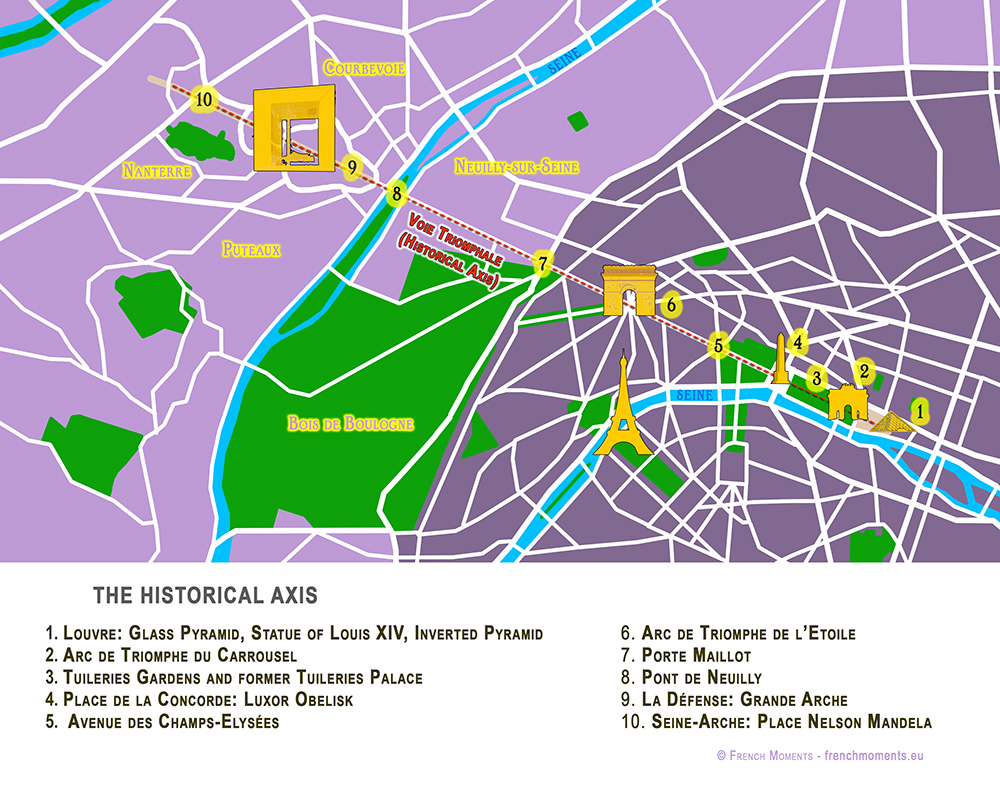
The Historical Axis runs through some of Paris’ most celebrated monuments and squares:
Let’s move along the Historical Axis of Paris, from East to West, starting from the Louvre.
The Palace of the Louvre

Today the great perspective starts at the Louvre, immediately beyond the Church of St Germain l’Auxerrois.
The crab-shaped Palace was the main residence of the kings of France until 1682, when Louis XIV, the ‘Sun King’, moved his court to Versailles. It currently houses one of the world’s most wonderful museums in a complex that is known as the “Grand Louvre”.
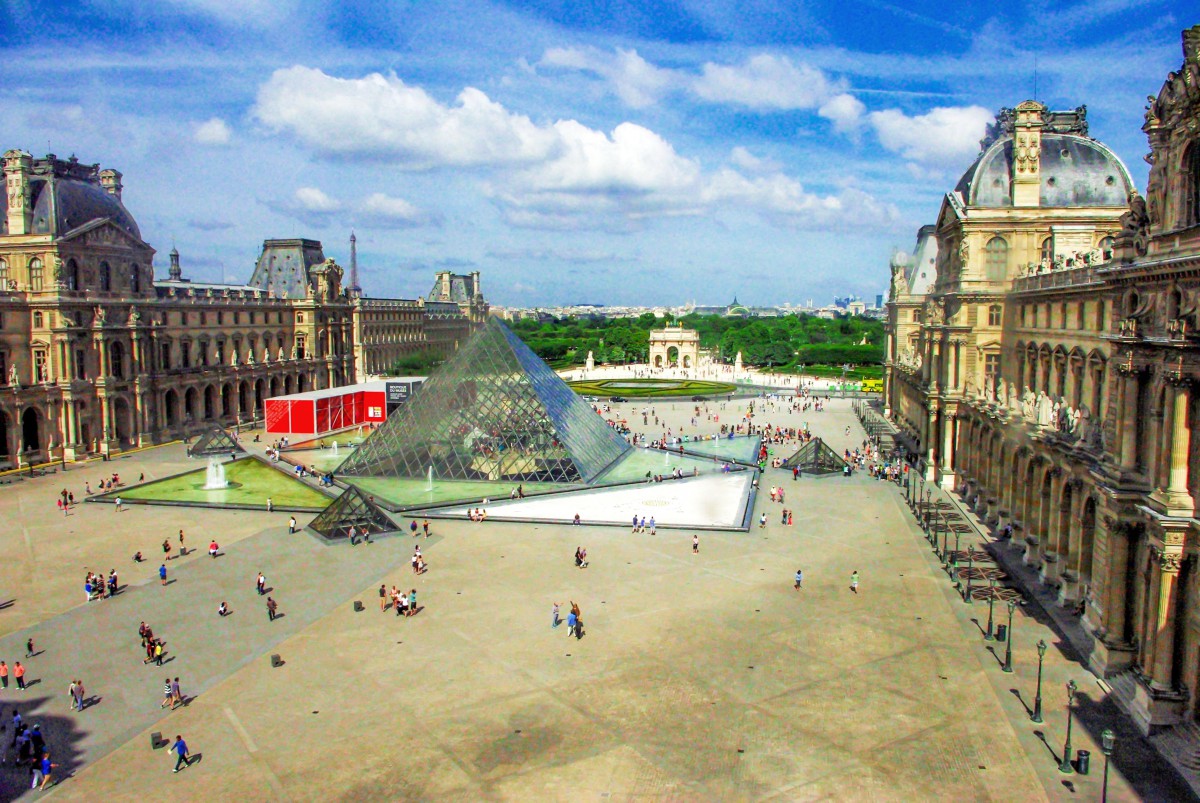 The Louvre today © French Moments The Louvre today © French Moments
The controversial glass pyramid of the Louvre
President François Mitterrand left his mark with his pharaonic project of “Le Grand Louvre”. He wished to complete it for the bicentennial celebration of the French Revolution in 1989. The titanic project comprised of major renovation works and the construction of a new landmark along the Historical Axis: the celebrated (and controversial) Glass Pyramid.
But if you look closer, you’ll notice that the glass pyramid is not aligned with the other monuments on the Historical Axis.
That’s why something had to be added in this vast courtyard of the Louvre…
https://frenchmoments.eu/historical-axis-of-paris-la-voie-triomphale/ |
|
|
|
|
LAST UPDATED: 27 NOVEMBER 2024
You may know Paris for its cathedral Notre-Dame, the Eiffel Tower, its café culture and its amazing museums and art galleries. The French capital is also famous for its fantastic perspective that runs from the Louvre to La Défense. This is the ‘Voie Triomphale’, aka the Historical Axis of Paris.
This line is one of the most prestigious perspectives in the world. In fact, its design has inspired cities such as Buenos Aires, Washington DC, New Delhi and Canberra. In this article, we’ll learn more about the Historical Axis of Paris. We’ll discover the stunning monuments and I reveal to you some stunning facts.
What is the Historical Axis of Paris?
 The glass pyramid and the historical axis of Paris © French Moments The glass pyramid and the historical axis of Paris © French Moments
The Historical Axis, also known in French as “Axe Historique”, “Voie Triomphale” or “Voie Royale” is orientated on a 26° angle.
It follows the course of the Sun from its rising in the East to its setting in the West.
Oddly, this angle of orientation is the same as that of Paris’ Notre-Dame Cathedral, some 1,000 metres away from the Louvre Palace.
More than just a series of monuments placed along the axis, it seems that a complex symbolism was at work in the mind of the successive urban planners.

The Historical Axis runs through some of Paris’ most celebrated monuments and squares:
Let’s move along the Historical Axis of Paris, from East to West, starting from the Louvre.
The Palace of the Louvre

Today the great perspective starts at the Louvre, immediately beyond the Church of St Germain l’Auxerrois.
The crab-shaped Palace was the main residence of the kings of France until 1682, when Louis XIV, the ‘Sun King’, moved his court to Versailles. It currently houses one of the world’s most wonderful museums in a complex that is known as the “Grand Louvre”.
 The Louvre today © French Moments The Louvre today © French Moments
The controversial glass pyramid of the Louvre
President François Mitterrand left his mark with his pharaonic project of “Le Grand Louvre”. He wished to complete it for the bicentennial celebration of the French Revolution in 1989. The titanic project comprised of major renovation works and the construction of a new landmark along the Historical Axis: the celebrated (and controversial) Glass Pyramid.
But if you look closer, you’ll notice that the glass pyramid is not aligned with the other monuments on the Historical Axis.
That’s why something had to be added in this vast courtyard of the Louvre…
https://frenchmoments.eu/historical-axis-of-paris-la-voie-triomphale/ |
|
|
|
|
Llama de la Libertad (París)
 La Llama de la Libertad, ofrecida al pueblo francés por donantes de todo el mundo como símbolo de la amistad franco-americana, en la plaza Diana (París).
La Llama de la Libertad (en francés, Flamme de la Liberté) de París es una réplica del mismo tamaño de la nueva llama situada en el extremo de la antorcha que lleva en la mano la Estatua de la Libertad de Nueva York desde 1986.1 El monumento, que tiene aproximadamente 3,5 metros de longitud, es una escultura de una llama de cobre dorado, apoyada en un pedestal de mármol gris y negro. Está situado cerca del extremo norte del puente del Alma, en la plaza Diana, en el distrito 8 de París, Francia.2
Fue ofrecida a la ciudad de París en 1989 por el International Herald Tribune en nombre de los donantes, que habían contribuido aproximadamente 400 000 dólares para su realización. Representaba la culminación de las celebraciones de 1987 del periódico por su cien aniversario de la publicación de un periódico en inglés en París. Más importante, la Llama era una muestra de agradecimiento por la restauración de la Estatua de la Libertad realizada tres años antes por dos empresas francesas que hicieron el trabajo artesanal del proyecto: Métalliers Champenois, que hizo el trabajo del bronce, y Gohard Studios, que aplicó el pan de oro. Aunque el regalo a Francia fue motivado por el centenario del periódico, la Llama de la Libertad es un símbolo más general de la amistad que une los dos países, igual que la Estatua de la Libertad cuando fue regalada a los Estados Unidos por Francia.
Este proyecto fue supervisado por el director de la unión de artesanos franceses en aquel momento, Jacques Graindorge. Propuso la instalación de la Llama de la Libertad en una plaza pública llamada Place des États-Unis en el distrito 16, pero el alcalde de París, Jacques Chirac, se opuso a esto. Tras un prolongado período de negociaciones, se decidió que la alama se situaría en una zona abierta cerca de la intersección de la Avenue de New-York y la Place de l'Alma. El monumento fue inaugurado el 10 de mayo de 1989 por Chirac.
En la base del monumento hay una placa conmemorativa que relata la siguiente historia:
"La Llama de la Libertad. Una réplica exacta de la llama de la Estatua de la Libertad ofrecida al pueblo de Francia por donantes de todo el mundo como símbolo de la amistad franco-americana. Con ocasión del centenario del International Herald Tribune, París 1887-1987."
La llama se convirtió en un monumento no oficial de Diana de Gales después de su muerte en 1997 en el túnel bajo el Pont de l'Alma.3 La llama es una atracción para turistas y seguidores de Diana, quiens pegan pósteres y folletos con material conmemorativo en la base. El antropólogo Guy Lesoeurs dijo que "la mayoría de las personas que vienen aquí piensan que se construyó para ella."2 La plaza del monumento se llama desde entonces Plaza Diana (París).
El monumento está cerca de la estación del Metro de París llamada Alma-Marceau en la línea 9 y de la estación Pont de l’Alma Línea 'C' del RER, así como por los buses número 42, 63, 72, 80, 92, y los autobuses turísticos Balabus.
El 14 de junio de 2008 se inauguró una nueva Llama de la Libertad, una escultura de Jean Cardot, que también simboliza las relaciones cálidas y respetuosas entre Francia y los Estados Unidos. Fue instalada en los jardines de la Embajada de los Estados Unidos en Francia en la Place de la Concorde, y se inauguró en presencia del Presidente de la República Francesa, Nicolas Sarkozy, y el Presidente de los Estados Unidos, George W. Bush. Esta nueva llama es la realización de un impulso compartido por el empresario francés Marc Ladreit de Lacharrière, y el embajador estadounidense Craig Roberts Stapleton, y tiene dos inscripciones, una del francés Marqués de La Fayette y otra del estadista americano Benjamin Franklin.
|
|
|
|
|
June 22 DC Metro subway trains collide - 9 dead, 80 injured
Timeline:
June 18-24: Gov. Sanford missing/crying in Argentina
June 21: 'Impact' Part 1 on ABC; Prince William birthday
June 22: DC Metro Red Line trains in collision
June 23: US Moon probes (LRO/LCROSS) reach Moon
June 24: Gov. Sanford reveals Argentine affair
June 25: Death of Michael Jackson & Farahh Fawcett
'Metro' means 'meter' in Spanish, Italian, Portuguese, etc. The meter is historically defined as 1/10,000,000 of the distance between the North Pole and the equator through Paris, or in other words the Paris Meridian between the North Pole and the equator. The Paris Meridian is also the 'Rose Line' (an esoteric concept popularized by The Da Vinci Code) i.e. a 'Red Line'...

DC Metro Red Line = French/Columbian Rose Line
...traditionally implying the Blood Royal/Sangraal or the Marian/Columbian Bloodline of the Holy Grail.
In Bloodline of the Holy Grail Laurence Gardner writes of the House of Stuart, the royal bloodline to which Princess Diana and her children belong (pp. 344-5):
https://www.goroadachi.com/etemenanki/moonwalker.htm |
|
|
|
|
ISLA SAN GIORGIO (VENECIA)=GEORGE LEMAITRE
|
|
|
|
|
Dimensions of the Cheops-pyramid (Khufu's pyramid)
Numbers and figures of the Cheops (Khufu) pyramid:
The pyramid of Khufu - Output / performance - Building material - Dimensions of the pyramid - Dimensions in Royal Cubits - Sources
 Cheops-pyramid (pyramid of Khufu) Cheops-pyramid (pyramid of Khufu)
Of the the famous Seven Wonders of the Ancient World the Great Pyramid of Khufu (Cheops) at Giza is the only one still standing. Even for modern men it is amazing how this man-made structure lasted so long.
The Giza pyramids must have made an incredible visual impact - at the edge of the desert three abstract geometrical symbols were rising, huge luminous white triangles reflecting the blinding light of the sun!
The pyramids on the Giza plateau are with 146.59m (Khufu / Cheops) and 143.87m (Khafre / Chefren) respectively the largest, however there are over 30 major pyramids and a myriad of smaller pyramids in Egypt.
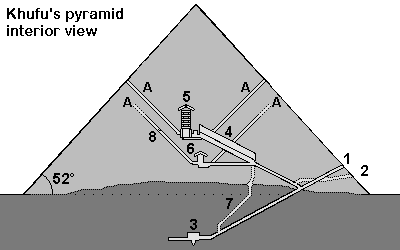
Cheops-Pyramid
1. Entrance 2. Entrance cut by grave robbers 3. Subterranean chamber 4. Grand Gallery 5. King's chamber, relieving chambers, granite portcullis slabs 6. Queen's chamber 7. Shaft 8. Limestone plugging the air shaft A= "Air shafts"
 Output / performance Output / performance
 Detailed calculations how many workers were necessary to build the pyramid Detailed calculations how many workers were necessary to build the pyramid
 Overview pyramid building Overview pyramid building
Builder
------------------- |
|
Khufu (Chuefui-Chnum or Khnum-Khuf, Cheops in Greek) during the 4th dynasty of the old kingdom |
| Time to build |
|
Probably max. 23 years (Khufu reigned from 2551 to 2528 before Christ *). Herodotus writes about 10 years of preparation and 20 years of building (details of the text) |
| Per day |
|
With 2'500'000 stones 342 stones have to be moved daily (working during 365 days a year) or 431 stones daily (working during 290 days a year). |
|
Per minute
|
|
10-hour day: every 2 minutes a stone (34 to 43 per hour)
8-hour day: nearly a stone every minute (42 to 53 stones per hour)
|
| Rule of thumb |
|
| While construction the pyramid the rate of delivery was 1 stone weighting 2.5 tons every minute. |
For our calculations we assume 500 stones a day. This is a rough estimate, assuming a 8-hour day, during 290 days a year, with 20 years to build the pyramid. Also assuming, that more time had to be used for the huge granite blocks for the King's chamber and for the more difficult upper part of the pyramid, where work went slower than in the lower parts. There probably were also other factors delaying the building of the pyramid such as the weather or a temporary shortage of certain building materials.
|
 Building materials for the Cheops-pyramid Building materials for the Cheops-pyramid
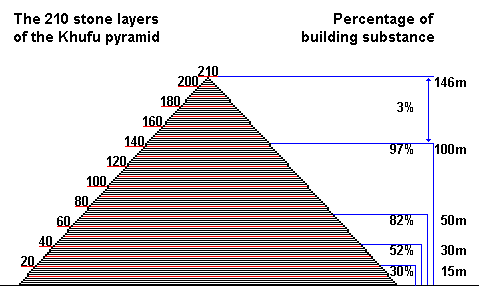
The Khufu-pyramid (Cheops) probably originally had 210 stone layers. At 50m height already 82% of the entire pyramid was built [3].
 Quarrying stones for the pyramid Quarrying stones for the pyramid
 Shipping the stone blocks down the Nile to Giza Shipping the stone blocks down the Nile to Giza
 Transporting the stone blocks using a sledge on tracks Transporting the stone blocks using a sledge on tracks
 Löhner's rope roll Löhner's rope roll
Stone blocks
------------------- |
|
2'300'000 stones |
| Casing blocks |
|
115'000 to 200'000 stones or 67'390m³ [1] |
| Total blocks |
|
2'500'000 stones |
| Stone layers |
|
Originally probably 210 stone layers, now only 201 layers [2] |
| Stone size |
|
The stone blocks usually are larger in the lower layers (1.5m = 3 cubit) and smaller in the upper layers. Most are between 1.5 and 2 cubit large (average of 127 x 127 x 71cm). 1 cubit = 0.524m - Details |
| Weight of the stone blocks |
|
With an average density of 2,6 - 2,9 t/m³ the large limestone blocks weighted 6.5 - 10 tons and the smaller ones about 1.3 tons. For all calculations on this website an average weight of 2.5 tons was used. |
| Special blocks |
|
For the King's chamber granite blocks weighting 40 to 50 tons were used |
| Total weight |
|
6'500'000 tons (average weight of a block was about 2.5 tons) |
| Pyramidion |
|
The final stone on the top was a large block in the shape of a pyramid. It was perhaps around 1.5m by 1.5m wide and 1.3m high (about 3 cubits). It was made from white Tura limestone (Turah), granite or perhaps diorite and perhaps gold plated. More information |
| Building materials |
|
Pyramid: Nummulite limestone from quarries about 200-400m south of the pyramid were used for the core stones.
Casing: light white limestone, so called Tura-limestone from quarries from the eastern shores of the Nile
King's chamber: Rose granite from Aswan 900km away
Further materials: Graywacke from the Wadi Hammamat (Eastern desert), basalt from the northern Faiyum
 Map of quarries in Egypt Map of quarries in Egypt
|
 Dimensions of the pyramid of Khufu Dimensions of the pyramid of Khufu
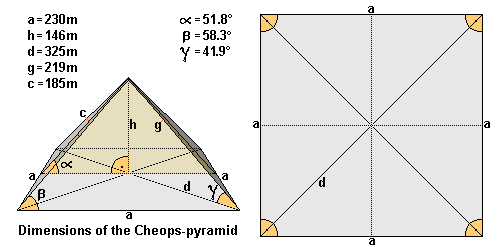
Length (a)
------------------- |
|
The average length of the edge is ~ 230.360m (230,12m = 440 cubits). Northern edge 230.328m - eastern edge 230.369m - southern edge 230.372m - western edge 230.372m. Largest difference is only 4.4cm. [3] |
| Height (h) |
|
Originally 146.59m high (= 280 cubits), the pyramid is now only 138.75m high [7] |
| Diagonal (d) |
|
325.77m |
| Ridge (g) |
|
219m |
| Height of the lateral surface |
|
186.42m |
| Pyramid angle α |
|
51° 50' 40' = inclination of the lateral surface (= 52° rounded off) [3] which corresponds to a seked of 5½ palms |
| Pyramid angle β |
|
58.3° = the two angles of the triangular lateral surface (62° = angle of the apex or tip of the pyramid) - nearly forming an equilateral triangle! |
| Pyramid angle γ |
|
41.9° = angle of the ridge |
| Corner angle |
|
Right angle base with angles from 89° 59' to 90° |
| Base area |
|
53'065.73m² |
| Superficies surface |
|
85'890.69m² |
| Pyramid volume |
|
2'592'968.43m³ including the rock core. This would be a cube with a length of 137.38m. Probable volume of stones used: 2'583'283m³ [1] or 2'326'501m³ [2]. |
| Alignment |
|
Exactly to the north (deviation only 2' 28') |
| Latitude and longitude |
|
N 29° 58’ 44.3830” latitude and E 31° 07’ 57.0194” longitude [5] |
| Altitude |
|
The base of the pyramid of Khufu lies about 60m above sea level, so the tip of the pyramid used to be on 206m above sea level [6]. |
 Alignment of the pyramids and controlling the shape of the pyramid (north-south alignment etc.) Alignment of the pyramids and controlling the shape of the pyramid (north-south alignment etc.)
 Dimensions of the pyramid of Khufu in Egyptian Royal Cubits Dimensions of the pyramid of Khufu in Egyptian Royal Cubits
 |
Length (a) |
|
440 Royal Cubits |
| Height (h) |
|
280 Royal Cubits |
| Height of the lateral surface (c) |
|
356 Royal Cubits (356.09) |
| Diagonal (d) |
|
622.25 Royal Cubits |
| Ridge (g) |
|
418.56 Royal Cubits |
| Pyramid angle α |
|
51.843° |
| Pyramid angle β |
|
58.3° |
| Pyramid angle γ |
|
41.9° |
| Corner angle |
|
90° |
It is suggested, that the Egyptians used a right angled triangle to determinate the angle of inclination of the pyramid, using the numbers a=11 and b=14 with c=17.8 (or a=22 - b=28 - c= 35.6). This determines a so called seked of 5½ palms.
 Alignment of the pyramids and controlling the shape of the pyramid (seked) Alignment of the pyramids and controlling the shape of the pyramid (seked)
 Sources Sources
[1] M. Lehner The Complete Pyramids of Egypt
[2] G. Goyon Die Cheops-Pyramide
[3] R. Stadelmann Die grossen Pyramiden von Giza
[4] F. Abitz Der Bau der grossen Pyramide mit einem Schrägaufzug
[5] GPS-coordinates of a brass disk on top of the pyramid of Khufu, Giza Plateau Mapping Project (GPMP)
[6] Maps of the Giza Plateau Mapping Project show the altitude as 60m
[7] D. Arnold Building in Egypt
* Dates according to conventional Egyptian chronology are used in this website. These are based on several list of the dynasties of pharaohs, for example the Aegyptiaca of Manetho of Sebennytos.
https://www.cheops-pyramide.ch/khufu-pyramid/khufu-numbers.html |
|
|
 Primeira Primeira
 Anterior
268 a 282 de 282
Seguinte Anterior
268 a 282 de 282
Seguinte
 Última
Última

|

